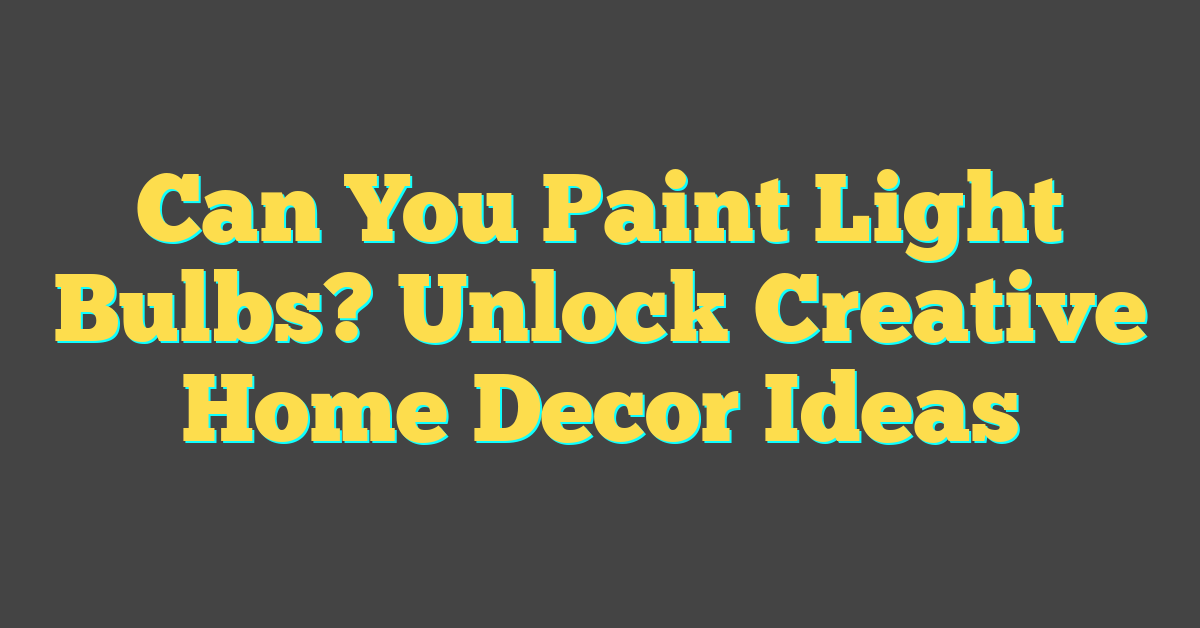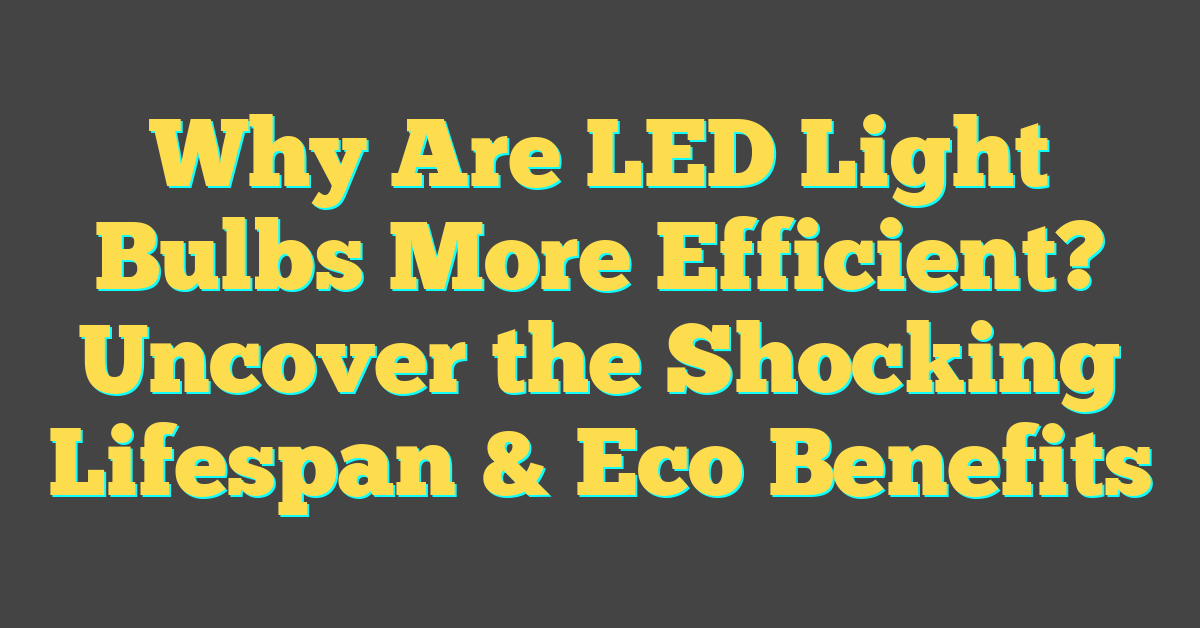Ever wondered where light bulbs can do their bright, brilliant thing? You’re not alone. From the cozy corners of your living room to the vast expanse of city streets, light bulbs are hard at work everywhere.

They’re not just about lighting up a room anymore. Today’s bulbs are smart, energy-efficient, and can even change colors to suit your mood. Let’s shed some light on the fascinating places these little illuminators make a big impact.
Functionality of Light Bulbs
When you’re tackling a new DIY project or simply replacing a burnt-out bulb, understanding the functionality of light bulbs can be a game-changer. Light bulbs don’t just brighten your space; they can influence mood, accentuate home decor, and even affect your utility bills.
First off, consider lumens and wattage. Lumens measure the amount of light emitted by a bulb, while wattage indicates power consumption. In today’s market, you’ll encounter a broad range of bulbs with varying lumens and wattages. Higher lumens generally mean brighter light, and thanks to energy-efficient designs like LEDs, you’ll get the same brightness for less wattage. This translates into energy savings and, ultimately, money saved on electricity.
Here’s a snapshot of average lumens per watt for different bulb types:
| Bulb Type | Lumens per Watt |
|---|---|
| Incandescent | 10-17 |
| Halogen | 12-22 |
| CFL | 35-60 |
| LED | 60-100+ |
Moving on to smart bulbs, they aren’t only convenient but also versatile. You can control them from your smartphone or with voice commands. They can dim, change colors, or even sync with your favorite tunes for an impromptu living room disco.
Color temperature is another consideration. Measured in Kelvins, it affects the look and feel of your space. Lower temperatures (2,700 – 3,000 K) emit a warm, cozy glow, ideal for living rooms or bedrooms. Higher temperatures (4,500 – 6,500 K) give off a cool white or bluish light, which is great for task lighting or enhancing concentration.
Here are some applications based on color temperature:
- Warm White (2,700 – 3,000 K): Perfect for lounge areas, restaurants, and other places seeking a comfy ambiance.
- Cool White (3,500 – 4,100 K): Suits offices, kitchens, and bathroom spaces where clarity and crisp lighting are essential.
- Daylight (5,000 – 6,500 K): Ideal for reading, intricate projects, or applying makeup where accuracy in color perception is critical.
Light Bulbs in Residential Areas

Light bulbs aren’t just functional; they’re an essential part of your home’s character. When you’re delving into home DIY projects, the types of bulbs you choose can dramatically transform each space.
In living rooms and dens, soft white LED bulbs are often the go-to choice. They create a warm, cosy atmosphere that’s perfect for relaxing after a busy day. With the ability to dim, you can adjust the brightness to match the mood you’re aiming for—whether it’s movie night or a quiet evening of reading.
Heading to the kitchen, task lighting takes precedence. Here, bright white or daylight bulbs can make all the difference. These bulbs have a higher lumen output, which helps in seeing finer details, crucial when you’re chopping veggies or measuring ingredients. Under-cabinet LED strips also add a modern touch while ensuring no corner is left in the shadows.
For the bathroom, the color temperature is key. Neutral white bulbs are ideal as they provide a clear representation of colors—essential for makeup application or shaving. Plus, LED bulbs designed for high moisture areas help combat rusting and wear in fixtures.
Bedrooms offer a chance to get creative. Ambient lighting using bulbs with a lower lumen count can set a serene environment suitable for winding down. But don’t forget task lighting for bedside reading. Clip-on or swing arm lamps with adjustable LED bulbs give you the control without disturbing your partner’s sleep.
Outside of the bedroom, don’t overlook hallways and staircases. Lighting here ensures safety and can act as night-time navigation. Low wattage LED bulbs or even smart bulbs, which you can control from your smartphone, work wonders. You can set them to turn on at specific times, or even respond to motion, ensuring you never have to fumble for a switch in the dark.
« Is Light Bulb Filament the Secret to Longer-Lasting Brightness?
What Light Bulbs Go in Wax Warmers? Find the Perfect Fit »
Each area within your home offers a unique opportunity to use light bulbs to your advantage. Remember, it’s not just about the bulb itself but where you place it and how it works in conjunction with your overall design vision. Embrace the variety and think about how different lighting options can both uplift the functionality and aesthetics of your space.
Light Bulbs in Commercial Spaces

When you’re selecting light bulbs for a commercial space, the stakes are a bit higher than in your home. Lighting needs to be efficient, cost-effective, and create a welcoming atmosphere for both employees and clients. Here’s what you’ll need to consider:
Prioritizing Efficiency and Cost
In a commercial setting, you’re often dealing with larger spaces and longer operating hours, which can result in significant energy consumption. LED bulbs are a game-changer in this regard, cutting down on both energy usage and costs. They emit less heat, reducing the need for air conditioning, and they last longer, which means replacing bulbs less frequently.
| Bulb Type | Average Lifespan | Energy Savings |
|---|---|---|
| LED Bulbs | 25,000 hrs | 75% |
| Traditional | 1,200 hrs | 0% |
Ensuring Optimal Lighting Conditions
For spaces like offices, the key is to reduce eye strain and improve productivity. That means choosing bulbs with:
- A color temperature that simulates daylight
- Enough lumens to deliver the right brightness without glare
Bright white or daylight LED bulbs often do the trick, creating an environment that helps maintain focus and energy levels.
Accent and Mood Lighting
Retail spaces benefit hugely from strategic lighting. Accent lighting draws customers’ eyes to products, while mood lighting can enhance the shopping experience. You’ll want to mix and match different types of bulbs to achieve these effects. Track lighting with LED spotlights can highlight products, and warmer, dimmable lights can soften the overall atmosphere.
Flexible Lighting Systems
In hospitality, such as restaurants or hotels, adaptability is crucial. Smart bulbs are invaluable as they can adjust for different events or times of day. With the ability to dim and change color at the tap of a smartphone, these bulbs help create the perfect ambience for any situation.
Remember, the right lighting can transform a commercial space from ordinary to extraordinary. Keep in mind the space’s function and how the lighting will play into the day-to-day activities there. Whether you’re illuminating a cozy café or an expansive warehouse, the correct light bulb is key to striking the balance between practicality and aesthetics.
Light Bulbs in Outdoor Environments

Stepping outside, the right lighting can extend the comfort of your home into the outdoors and dramatically transform any exterior space. Regardless of whether you’re illuminating a porch, garden, or walkway, your choice in bulbs should withstand the elements while providing the desired ambiance.
Outdoor lighting serves multiple purposes; it enhances security, creates mood, and highlights the landscape to reflect your personal style. Start by considering LED bulbs for your outdoor fixtures—they’re energy efficient, durable, and have a longer lifespan, which is ideal considering the difficulties of changing lights in some outdoor settings.
When selecting bulbs for the outdoors, be sure to check if they’re rated for wet or damp locations, especially if they’re not going to be used in completely covered areas. Look for IP ratings (Ingress Protection), as bulbs with higher numbers offer better protection against dust and water—a must for outdoor conditions.
For security lighting like floodlights, bright, motion-activated LED bulbs are your best bet. These flood areas with light at the slightest detection of movement, acting as a deterrent for unwelcome visitors. If you’re focusing on garden paths, softer bulbs placed at intervals ensure visibility without overpowering the space with harsh light.
Warm, low-intensity bulbs can add a cozy glow to outdoor seating areas, ideal for evenings spent under the stars. Your deck or patio becomes a continuation of your indoor living space with the right lighting choices.
Accent lighting is another outdoor element you can’t overlook. It can be used to spotlight sculptures, trees, or architectural details of your home. Halogen bulbs are often recommended for spotlights because they provide a crisp, white light that really makes features stand out.
Adjustable smart outdoor bulbs add convenience and versatility, as they can be controlled remotely, and settings can be changed to suit any mood or gathering you’re hosting. They have the added benefit of adapting to your schedule, ensuring lights are on when you need them and off when you don’t.
For each area of your outdoor space, consider:
- Security: Bright, motion-activated LED bulbs
- Pathways: Soft, low-intensity LED bulbs
- Seating Areas: Warm, low-intensity bulbs for a comfortable ambiance
- Accent: Halogen bulbs for spotlighting features
Conclusion
You’ve seen how the right light bulb can transform any space from your cozy living room to bustling commercial settings and even your outdoor oasis. Remember, it’s not just about brightening a room but creating the perfect ambiance, enhancing safety, and being mindful of energy consumption. So go ahead, make those smart, luminous choices that’ll not only reflect your style but also cater to functionality and efficiency. Your spaces are just a switch away from the ideal lighting they deserve. Happy illuminating!
Frequently Asked Questions
What affects mood and utility bills in terms of light bulbs?
Light bulbs can influence mood and utility bills by their brightness, color temperature, and energy efficiency. Choosing bulbs with appropriate lumens, color temperature, and energy-efficient technology like LEDs can enhance decor and reduce costs.
How do lumens and wattage affect the choice of a light bulb?
Lumens measure the brightness of a bulb, while wattage measures energy consumption. Higher lumens provide more light, and lower wattage bulbs consume less energy, making it important to balance the two when choosing a bulb.
What are the benefits of LED bulbs?
LED bulbs are energy-saving, have a longer lifespan than traditional bulbs, and are available in various color temperatures and brightness levels. They contribute to lower electricity bills and are environmentally friendly.
Can smart bulbs be controlled from a smartphone?
Yes, smart bulbs can be controlled from a smartphone. They provide convenience and versatility with features such as dimming, color-changing, and scheduling.
Why is color temperature important in light bulbs?
Color temperature influences the atmosphere of a space. It ranges from warm to cool hues, with warm light creating a cozy ambience and cool light being invigorating and better for concentration.
What types of light bulbs should I use in different areas of the home?
Use soft white LED bulbs for living rooms, bright white or daylight for kitchens, and neutral white for bathrooms. Lighting in bedrooms, hallways, and staircases should be functional and safe.
What type of lighting is recommended for commercial spaces?
Commercial spaces benefit from LED bulbs for their efficiency and extended lifespan. Optimal lighting conditions are needed in offices to prevent eye strain, while retail spaces require a mix of bulbs for accent and mood lighting.
How should I choose the right light bulbs for outdoor areas?
Select LED bulbs for energy efficiency and durability. Ensure they are rated for wet or damp conditions and have high IP ratings. Use bright motion-activated bulbs for security and softer bulbs for garden paths or seating areas.




